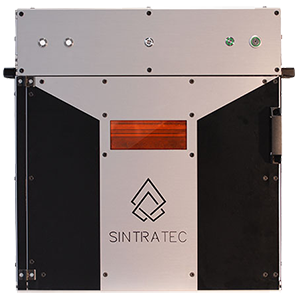Sintratec Sintra
Pros:
1. The first ever laser sintering 3D printer
2. Remarkably low priced
Cons:
1. Technology not completely proven in the market yet
2. Smallest build sizes in its class
3. Slowest extrusion speeds in its class
 The Sintratec Sintra is one of the most innovative new 3D printers we have seen since the technology became popular a little more than a year ago. We expect it to make a huge noise in the industry and redefine not only how 3D printing is done, but also redefine materials that are used. Their new polymer compound filament (Polyamide 12 Thermo Powder) has shown a great deal of promise in the company’s demos and they assure the public that it is not only a better material in many ways, but more cost effective as well.
The Sintratec Sintra is one of the most innovative new 3D printers we have seen since the technology became popular a little more than a year ago. We expect it to make a huge noise in the industry and redefine not only how 3D printing is done, but also redefine materials that are used. Their new polymer compound filament (Polyamide 12 Thermo Powder) has shown a great deal of promise in the company’s demos and they assure the public that it is not only a better material in many ways, but more cost effective as well.
There have been too many times that we have seen a product like this, with plenty of promise and bang in the demos, just end up falling flat for one reason or another, never getting off the ground. The Sintra, on the other hand, seems to be well on its way to making some serious waves in the industry. Laser Sintering Technology, which is what this printer is built upon, is one of the more fascinating advancements we have seen in this particular type of product.
With a build size of 130 x 130 x 130 mm (about 5 x 5 x 5 inches), there aren’t as many possible applications as with other 3D printers that implement fusion techniques. The 70mm/s printing speeds are considerably slower than a lot of other printers of different sizes and classes. It is also seemingly prohibitive at first glance, appearing to be too slow to really be practical. We do believe, however, that the laser sintering technology and the polymer materials make up for this, as well as the precision. With these things combined, plus a 40 micron layer resolution, it is possible to achieve a good, happy medium between durability and detail.
We also found the footprint to build ratio on the Sintra to be really high, especially when you are producing such a small build. At 21.7″ x 20.9″ x 14.2″ there is an awful lot of room taken up on a desk or other tabletop surface in exchange for a 5 square inch build potential. Although this may be fine in an industrial setting, a machine of this size being relatively small compared to certain other types of manufacturing equipment, it is impractical in a home setting. The fact that this isn’t rated as a home enthusiast’s machine, though, is no surprise when you look at the price point of the printer alone. But with their efforts to lower the cost of materials and provide more durable builds, there is no doubt in our minds that this printer is intended solely for business applications.
Support is also very limited on this product at this time, which is to be expected before it is actually released to the public. The contact form at the bottom of their page however, along with their kickstarter page, should provide means for you, if you are interested in pre-ordering this printer, to receive answers to any questions you may have. Despite some of the comparatively lesser features of this printer, and due to its innovation in the industry and enormous potential, we are happy to include the Sintratec Sintra on our list of iReviews 2015 best 3D printers over $5,000.
Related YouTube videos:
